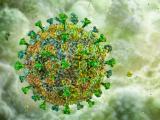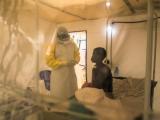An investigation by Liberian health officials and experts from the US Centers for Disease Control and Prevention (CDC) into Liberia's last Ebola case builds a strong case for sexual transmission as the source of the woman's infection.
Though the group's probe doesn't definitively prove a link, what they found was solid enough—including part of a matching genetic signature—to form the basis for the cautious recommendations for survivors recently made by Liberia's government, the World Health Organization, and the CDC. The team published its investigation findings today in an early online edition of Morbidity and Mortality Weekly Report (MMWR).
Liberia's last Ebola case was in a 44-year-old woman who got sick Mar 14 and died from her infection. The team found that her only epidemiologic link to the virus was unprotected vaginal sex 1 week earlier with a 46-year-old man who had been sick with a presumed Ebola infection in September.
Lab findings yield key clues
Genetic sequencing of the virus found in the woman's blood sample revealed six mutations not found in 25 genomes sequenced from Liberia or 107 genomes obtained from Guinea, Mali, and Sierra Leone.
When investigators looked at the history of the man's illness, they found that he started experiencing symptoms consistent with the disease on Sep 9 and was admitted to an Ebola treatment unit on Sep 23 where results of the first RT-PCR (reverse-transcriptase polymerase chain reaction) test Sep 28 were indeterminate, followed by negative results on a second test conducted 8 days later.
Around the time the man was ill, several of his family members had confirmed or suspected Ebola infections.
In reviewing the man's recent activities, the group found that the man had also had unprotected vaginal sex 3 to 5 times with another woman in February and March. Blood tests on the woman in late March found no evidence of exposure to the Ebola virus.
Recent blood samples from the man were negative on RT-PCR testing but positive for Ebola nucleoprotein on antibody testing.
A recent semen sample (199 days after his illness onset) was positive on RT-PCR testing and yielded low levels of viral RNA. Sequencing conducted so far on 28% of the Ebola genome from the man's semen showed that it closely matched the woman's.
All Liberian Ebola cases since Jan 21 have been linked to a single transmission chain, and the woman's sequences didn't match viral RNA samples from 3 of 22 recently confirmed cases that were sequenced for comparison.
The team concluded that available epidemiologic and lab evidence suggests that the woman may have been exposed to the Ebola virus through sexual contact with the man. Although the recent viral RNA in his semen doesn't prove that infectious virus is present, the lack of a matching genetic signature with any other recent cases makes it unlikely that the woman was exposed by an unrecognized source in the community.
Findings prompt more tests, recommendation considerations
Plans have been made to culture a semen specimen to see if viable virus is present, the group wrote. They also noted that lab personnel are working to amplify the Ebola virus RNA in the semen sample with the goal of doing more complete genome sequencing.
Unpublished investigation findings from several other recent Ebola cases in West Africa also suggest sexual transmission from survivors, and more studies are planned to pin down clearance, persistence, and shedding of Ebola virus in the body fluids of survivors.
PCR testing in semen might be a useful tool for counseling male survivors on steps to take to prevent disease transmission, and health officials are reviewing the data to see if a recommendation is feasible, according to the report.
Vaccine viability tests
Ebola virus stability tests on three materials typically found in West African Ebola treatment units found differences in controlled hospital conditions and tropical conditions. The team from the National Institutes of Health (NIH) Rocky Mountain Laboratories in Hamilton, Mont., reported their findings yesterday in an early online edition of Emerging Infectious Diseases.
The three materials were stainless steel, plastic, and Tyvek from the front of a pair of protective coveralls; researchers tested the virus viability in two different conditions: that of a climate-controlled hospital and that of a warmer, more humid West African environment. They also tested virus stability in water, human blood, and macaque blood.
They found that the Ebola virus persists longer on surfaces in climate-controlled hospital conditions than in tropical conditions and is viable for longer in liquid than in dried blood.
See also:
May 1 MMWR report
Apr 30 Emerg Infect Dis report


















